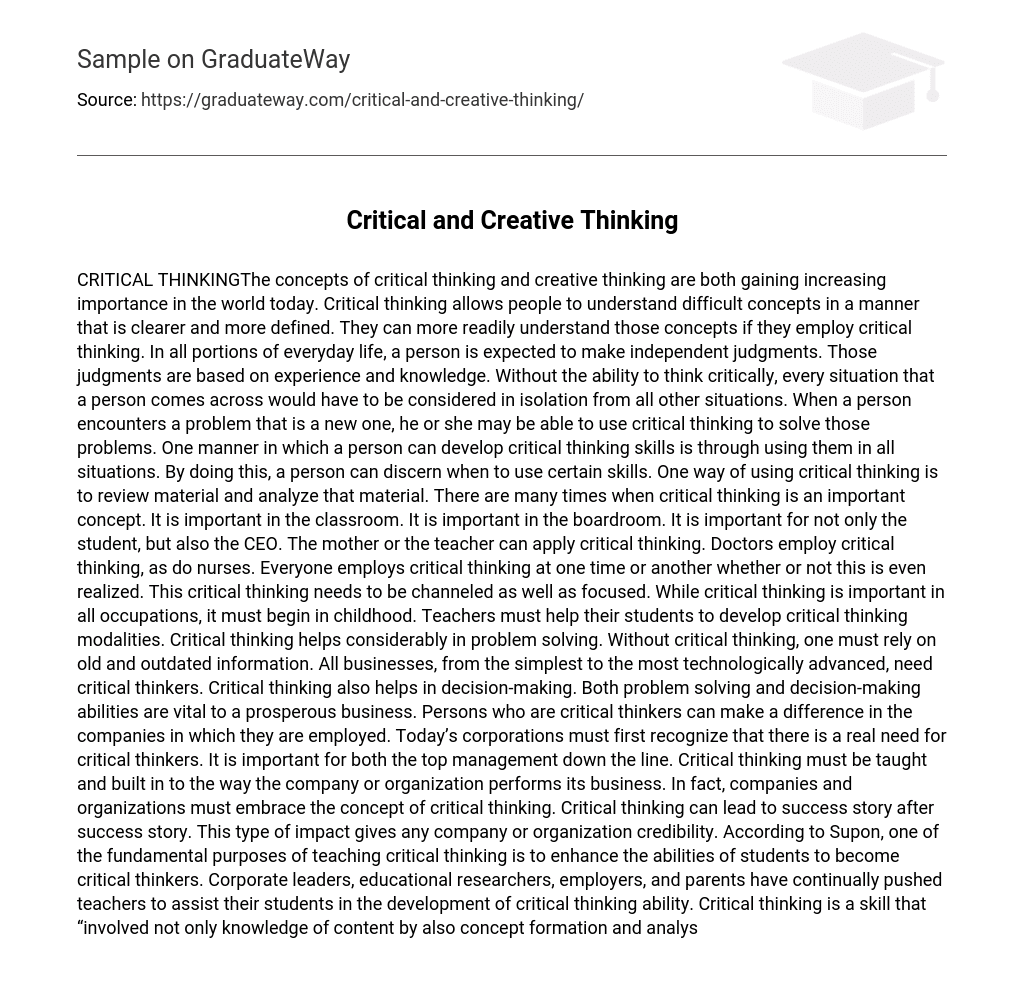In today’s world, the importance of critical thinking and creative thinking is on the rise. Critical thinking helps us gain a clearer and more precise understanding of difficult concepts, thereby facilitating comprehension of various situations. Independent judgments based on experience and knowledge are essential in everyday life. Without critical thinking skills, each situation would have to be evaluated individually. When encountering new problems, critical thinking can aid in finding solutions. Developing these skills entails their application across all scenarios to determine their relevance. One approach to employing critical thinking is through reviewing and analyzing material. Not only is it a vital concept in classrooms but also in boardrooms, providing benefits for both students and CEOs.
Critical thinking is an essential skill that can be utilized by people in various roles, including mothers, teachers, doctors, nurses, and individuals from all backgrounds. It is crucial to direct and concentrate this critical thinking. While it is necessary in every profession, it must be nurtured during childhood with the assistance of educators. Critical thinking plays a significant role in problem-solving and helps avoid dependence on outdated information. All businesses, regardless of their complexity level, require individuals who can think critically. Moreover, critical thinking aids in decision-making which is crucial for the success of any company. Corporate leaders must recognize the significance of critical thinkers and ensure its integration throughout their organization.
Critical thinking is crucial for companies and organizations in their daily operations. Embracing the concept of critical thinking can lead to consistent success stories, which in turn enhances the credibility of any company or organization. Teaching critical thinking has the fundamental purpose of strengthening students’ ability to think critically. Educational researchers, employers, and parents consistently urge teachers to aid students in developing their critical thinking skills. Critical thinking involves various cognitive activities such as acquiring knowledge, forming concepts, analyzing, reasoning, drawing conclusions, and recognizing contradictions (Supon, 1998).
There is currently a focus on critical thinking, which can be attributed to various factors. These factors encompass economic shifts globally, the dissemination of vast amounts of information, and occupational mobility (Supon, 1998).
Creating thinking classrooms can be challenging for educators due to several barriers. These barriers include educators feeling insecure about their own critical thinking abilities, students fearing ridicule from their peers when sharing their experiences, and teachers being attached to the lecture method. However, Supon (1998) points out that there are multiple strategies to overcome these barriers.
According to Kirby and Goodpaster, the teacher’s approach to teaching critical thinking needs to be transformed. They argue that there is no universal method for promoting critical thinking in the classroom. To foster students’ development of critical thinking skills, it is crucial to allow them to participate in meaningful and enthusiastic learning experiences. Teachers can enhance their own abilities by attending seminars, staff meetings, and reading educational journals that focus on teaching thinking. It is necessary to use alternative teaching methods to disrupt the routine pattern of thinking and promote critical thinking. Ultimately, teachers must engage in critical thinking themselves in order to effectively teach students how to do so (Moore and Parker, 2000).
According to Moore and Parker (2000), when educators support their students in acquiring the essential “practical wisdom” needed for learning, it promotes critical thinking. This occurs when students realize the connection between their immediate concerns and a specific instructional theory, leading to the development of higher standards of thinking. Kirby and Goodpaster (1999) further emphasize that critical thinking is a crucial component of higher-level thinking.
Critical thinking can be fostered in students by legitimizing their experiences and ideas, enabling them to recognize the importance of their own thoughts. The objective of achieving this can be accomplished through collaborative activities and classroom discussions. However, for critical thinking to thrive, it is necessary for teachers to establish a non-judgmental environment. According to Moore and Parker (2000), critical thinking skills are developed when teachers purposefully integrate content with students’ ideas and experiences. This intentional inclusion of elements in teaching methods helps students become aware of their own behaviors, ideals, and values, which is essential for critical thinking, as emphasized by Kirby and Goodpaster (1999).
Building trust in the classroom is crucial for teachers to validate their students’ experiences. The key to establishing trust lies in mutual respect, as educators can gain it by showing respect towards their students. Once trust is established, teachers can then concentrate on nurturing critical thinking skills. When students trust their teachers, they are more inclined to openly share their experiences and ideas without fear of peer ridicule or judgment. This fosters an environment where students recognize the value and validity of their own thoughts and experiences (Supon, 1998).
Students can develop knowledge bases by visualizing important facts and concepts. This involves “creating mental pictures to aid in learning, thinking, and problem-solving” (Supon, 1998). Critical thinking involves problem-solving and when a student’s concepts are visual and organized, it improves their ability to communicate information and ideas effectively. In addition to enhancing critical thinking skills, visualization can also generate excitement and interest in students (Supon, 1998).
Critical thinking is crucial in education. Without it, teachers would fail students, potential would be wasted, businesses would collapse, doctors and nurses would struggle to provide care, CEOs would not succeed, and students could not write research papers. The importance of critical thinking cannot be emphasized enough. It must be taught and learned. Ignoring this way of thinking would lead to significant setbacks. Critical thinking is necessary for effective communication, comprehending vital ideas, making choices, and resolving problems in all aspects of life.





